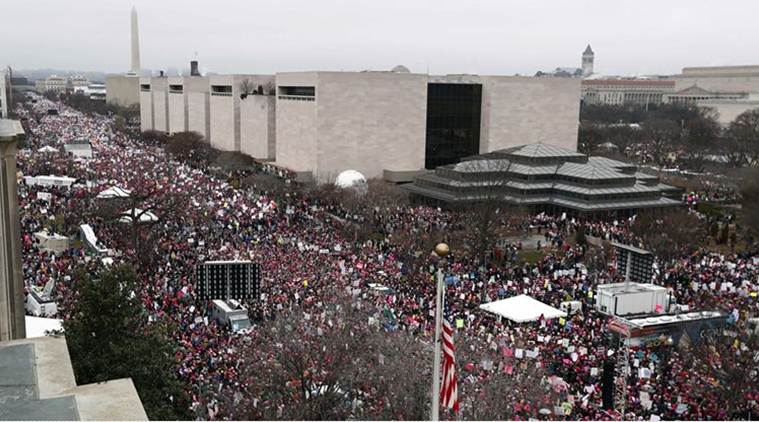Every year at this time the March for Life descends on Washington, like anti-abortion swallows returning to Capistrano. And every year, organizers complain that the media ignores the march, evidence of liberal media bias against the pro-life movement.
As Tim Graham of the conservative Media Research Center told Washington Times in 2009:
Anyone climbing on a bus from somewhere else, thinking they’re going to wave into a network news camera, is going to be very disappointed. In the last 20 years, despite large annual crowds, the liberal manufacturers of TV have simply never found the March for Life to be the slightest bit newsworthy.
But despite the dubious newsworthiness of an event that’s been happening for nearly 45 years and attracts a respectable, but hardly earthshattering crowd, the mainstream media dutifully reports every year on the march and airs the claims of the anti-abortion movement that its true scope and support is routinely ignored, despite polling that consistently shows a solid majority of Americans believe abortion should be legal in all or most cases.
This year there’ve been four stories ignoring the march (before it’s even begun) in the Washington Post alone: one about the upbeat mood at the march in the wake of Donald Trump’s promise to crack down on abortion; an article questioning whether the march can heal the divide in the anti-abortion movement over Trump; a piece from John Gehring about how the march will show that pro-life doesn’t stop at birth; and an article about thousands assembling for the march.

For comparison, this photo is from the 2017 Women’s March in DC. Neither the beginning nor the end of the crowd is visible and there’s no space on the sides.
From the New York Times, we got an article about how the march was looking to compete with last week’s Women’s March on Washington and how “a large coalition of anti-abortion groups have banded together to pressure television and cable networks to devote the same kind of media coverage to the March for Life as they devoted to the women’s march.”
According to the Alliance for Fair Coverage of Life Issues:
The media are no longer the watchdogs for the American public, but the lapdogs of a liberal agenda committed to the destruction of life. The Alliance for Fair Coverage of Life Issues calls out journalists for their ongoing blackout of pro-life news and demands reporters live up to the standards of journalistic integrity by covering life issues.
The Alliance complains that the mainstream TV networks devoted less than two minutes to the march over the last four years and that papers like the Post routinely downplay the march. It’s true that coverage of the march does wax and wane. A march in the first year of an administration that promised to take a strong stance against abortion is likely to get more coverage than one that happens in the seventh year of a pro-choice administration when there’s no major abortion issue on the national agenda.
But it’s also true that the mainstream media has bent over backwards to cover what at best is an annual act of political theater designed to create the impression of a large and energized grassroots anti-abortion movement. Despite claims of organizers that the march routinely draws some 250,000 protestors and that during the 2013 march marking the 40th anniversary of Roe v. Wade flooded Washington with 650,000 protestors—the number organizers are now using to say their march should draw the same kind of media coverage as the Woman’s March—anyone who has ever covered the march knows that that’s Trump-like wishful thinking about crowd size.
Most media coverage of the march optimistically reports attendance in the “tens of thousands.” But that often equates to some 20,000 or 30,000 marchers. Even Tim Graham, in his 2009 rant against the media admitted:
Everyone knows that a single Cindy Sheehan in the summer seems to be worth more than 20,000 pro-lifers in January.
And that’s exactly what the March for Life typically is: about 20,000 pro-lifers milling around Washington in January, in which case the media coverage it receives every year has actually been generous. And it’s important to note that the march is hardly some spontaneous outpouring of grassroots anti-abortion opposition. Since its start in 1974, the March for Life has relied heavily on Catholic and evangelical students bused en masse in from elementary and high schools and students from pro-life college organizations. In fact, turnout at the march was notably scarce last year when a snowstorm stranded buses full of students on the Pennsylvania Turnpike.
The March for Life has always been somewhat of a publicity stunt: part political theater, part rallying point for the committed faithful of the pro-life movement, part exercise in media grievance building for the Christian Right.
And now that it’s clear that this year’s march won’t come close to the numbers of the Women’s March, despite guest stars like VP Mike Pence. With only about 100 buses permitted for the city, compared to 1,800 for the Women’s March, organizers are suddenly claiming it’s not about the numbers after all. March for Life President Jeanne Mancini told the Times:
I don’t think that these numbers are the most important. The number most important for us is 58 million, which is the number of Americans that have been lost to abortion.
But either they have the numbers or they don’t. And if they don’t, maybe the media should take a hard look at how it covers a predictable, lightly attended act of agitprop which claims to represent hundreds of thousands of people who never show up.


